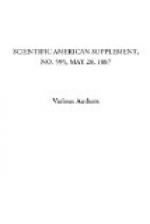On the first day. 15 conidia.
" second day.
17 "
" third day.
27 "
" fourth day.
4 "
" fifth day.
9 "
“On none of the five nights did a single conidium alight on the slides. This seemed to me to prove that during the day the conidia, through the dryness of the atmosphere and the shaking of the leaves, became detatched and wafted by the air; while during the night the moisture (in the form of dew, and on one occasion of a slight and gently falling shower) prevented the drying of the conidia, and thus rendered them less easy of detachment.
“I determined the nature of the conidia (1) by comparing them with authentic conidia directly removed from diseased plants; (2) by there being attached to some of them portions of the characteristic conidiaphores; and (3) by cultivating them in a moist chamber, the result of which was, that five conidia, not having been immersed in the glycerine, retained their vitality, which they showed by bursting and producing zoospores in the manner characteristic of Peronospora infestans.”
INFLUENZA.
Let us look at another disease by the light of recent knowledge, viz., the epidemic influenza, concerning which I remember hearing much talk, as a child, in 1847-48. There has been no epidemic of this disease in the British Isles since 1847, but we may judge of its serious nature from the computation of Peacock that in London alone 250,000 persons were stricken down with it in the space of a few days. It is characteristic of this disease that it invades a whole city, or even a whole country, at “one fell swoop,” resembling in its sudden onset and its extent the potato disease which we have been considering.
The mode of its spreading forbids us to attribute it, at least in any material degree, although it may be partially so, to contagion in the ordinary sense, i.e., contagion passing from person to person along the lines of human intercourse. It forbids us also to look at community of water supply or food, or the peculiarities of soil, for the source of the disease virus. We look, naturally, to some atmospheric condition for the explanation. That the atmosphere is the source of the virus is made more likely from the fact that the disease has broken out on board ship in a remarkable way. In 1782, there was an epidemic, and on May 2 in that year, says Sir Thomas Watson—
“Admiral Kempenfelt sailed from Spithead with a squadron, of which the Goliah was one. The crew of that vessel were attacked with influenza on May 29, and the rest were at different times affected; and so many of the men were rendered incapable of duty by this prevailing sickness, that the whole squadron was obliged to return into port about the second week in June, not having had communication with any port, but having cruised solely between Brest and the Lizard. In the beginning of the same month another large squadron sailed, all in perfect health, under Lord Howe’s command, for the Dutch coast. Toward the end of the month, just at the time, therefore, when the Goliah became full of the disease, it appeared in the Rippon, the Princess Amelia, and other ships of the last mentioned fleet, although there had been no intercourse with the land.”




